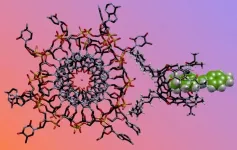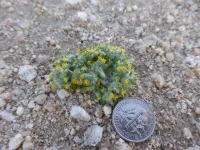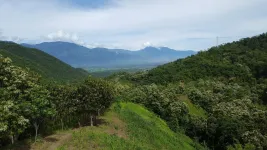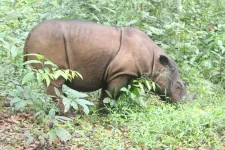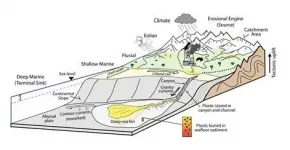One cup of leafy green vegetables a day lowers risk of heart disease
New Edith Cowan University (ECU) research has found that by eating just one cup of nitrate-rich vegetables each day people can significantly reduce their risk of heart disease.
2021-05-04
(Press-News.org) New Edith Cowan University (ECU) research has found that by eating just one cup of nitrate-rich vegetables each day people can significantly reduce their risk of heart disease.
The study investigated whether people who regularly ate higher quantities of nitrate-rich vegetables, such as leafy greens and beetroot, had lower blood pressure, and it also examined whether these same people were less likely to be diagnosed with heart disease many years later.
Cardiovascular diseases are the number one cause of death globally, taking around 17.9 million lives each year.
Researchers examined data from over 50,000 people residing in Denmark taking part in the Danish Diet, Cancer, and Health Study over a 23-year period. They found that people who consumed the most nitrate-rich vegetables had about a 2.5 mmHg lower systolic blood pressure and between 12 to 26 percent lower risk of heart disease.
Lead researcher Dr Catherine Bondonno from ECU's Institute for Nutrition Research said identifying diets to prevent heart disease was a priority.
"Our results have shown that by simply eating one cup of raw (or half a cup of cooked) nitrate-rich vegetables each day, people may be able to significantly reduce their risk of cardiovascular disease," Dr Bondonno said.
"The greatest reduction in risk was for peripheral artery disease (26 percent), a type of heart disease characterised by the narrowing of blood vessels of the legs, however we also found people had a lower risk of heart attacks, strokes and heart failure."
Forget the supplements
The study found that the optimum amount of nitrate-rich vegetables was one cup a day and eating more than that didn't seem to give any additional benefits.
"People don't need to be taking supplements to boost their nitrate levels because the study showed that one cup of leafy green vegetables each day is enough to reap the benefits for heart disease," Dr Bondonno said.
"We did not see further benefits in people who ate higher levels of nitrate rich vegetables."
Smoothies are ok
Dr Bondonno said hacks such as including a cup of spinach in a banana or berry smoothie might be an easy way to top up our daily leafy greens.
"Blending leafy greens is fine, but don't juice them. Juicing vegetables removes the pulp and fibre," Dr Bondonno said.
The paper "Vegetable nitrate intake, blood pressure and incident cardiovascular disease: Danish Diet, Cancer, and Health Study" is published in the European Journal of Epidemiology. It is a collaboration between Edith Cowan University, the Danish Cancer Society and The University of Western Australia.
The research adds to growing evidence linking vegetables generally and leafy greens specifically with improved cardiovascular health and muscle strength. This evidence includes two recent ECU studies exploring cruciferous vegetables and blood vessel health and green leafy vegetables and muscle strength.
INFORMATION:
ELSE PRESS RELEASES FROM THIS DATE:
2021-05-04
In a recent article in Sustainability, scientists from Reykjavik University (RU), the University of Gothenburg, and the Icelandic Meteorological Office describe their finding of microplastic in a remote and pristine area of Vatnajokull glacier in Iceland, Europe's largest ice cap. Microplastics may affect the melting and rheological behaviour of glaciers, thus influencing the future meltwater contribution to the oceans and rising sea levels.
This is the first time that the finding of microplastic in the Vatnajökull glacier is described. The group visualised and identified microplastic particles of various sizes and materials by optical microscopy and μ-Raman spectroscopy.
The discussion about microplastics has mainly been focused on the contamination ...
2021-05-04
Over the coming decades, our economy and society will need to dramatically reduce greenhouse gas emissions as called for in the Paris Agreement. But even a future low-carbon economy will emit some greenhouse gases, such as in the manufacture of cement, steel, in livestock and crop farming, and in the chemical and pharmaceutical industries. To meet climate targets, these emissions need to be offset. Doing so requires "negative emissions" technologies, by means of which CO2 is removed from the atmosphere and permanently stored in underground repositories.
Researchers at ETH Zurich have now calculated the potential of one of these technologies for Europe: the combination of energy extraction from biomass with the capture and ...
2021-05-04
Small changes in the structure of DNA have been implicated in breast cancer and other diseases, but they've been extremely difficult to detect -- until now.
Using what they describe as a "chemical nose," UC Riverside chemists are able to "smell" when bits of DNA are folded in unusual ways. Their work designing and demonstrating this system has been published in the journal Nature Chemistry.
"If a DNA sequence is folded, it could prevent the transcription of a gene linked to that particular piece of DNA," said study author and UCR chemistry professor Wenwan Zhong. "In other words, this could have a positive effect by silencing a gene with the potential to cause cancer or promote tumors."
Conversely, DNA folding ...
2021-05-04
Talking about your bad day at work could lead to great solutions. Cold Spring Harbor Laboratory (CSHL) Associate Professor Saket Navlakha and his wife, Dr. Sejal Morjaria, an infectious disease physician at Memorial Sloan Kettering Cancer Center (MSK), found a way to predict COVID-19 severity in cancer patients. The computational tool they developed prevents unnecessary expensive testing and improves patient care.
Morjaria says, "Generally, I have good intuition for how patients will progress." However, that intuition failed her when confronted with COVID-19. She says:
"When the pandemic ...
2021-05-04
Below please find summaries of new articles that will be published in the next issue of Annals of Internal Medicine. The summaries are not intended to substitute for the full articles as a source of information. This information is under strict embargo and by taking it into possession, media representatives are committing to the terms of the embargo not only on their own behalf, but also on behalf of the organization they represent.
1. Increased use of minimally invasive non-endoscopic tests for Barrett's esophagus screening could impact detection and prevention of esophageal cancer
Abstract: https://www.acpjournals.org/doi/10.7326/M20-7164
URL ...
2021-05-04
Throughout the history of the West, human actions have often rushed the desert -- and their actions backfired. In the 1920s, the Colorado River Compact notoriously overallocated water still used today by several western states because water measurements were taken during a wet period.
More currently, operators of the massive Ivanpah Solar Electric Generating System in the Mojave Desert are spending around $45 million on desert tortoise mitigation after initial numbers of the endangered animals were undercounted before its construction.
A study published in the journal Ecological Applications from the University of California, Davis, and UC Santa Cruz warns against another potential desert timing mismatch amid the race against climate change and toward rapid renewable ...
2021-05-04
The importance of pollinators to ensure successful harvests and thus global food security is widely acknowledged. However, the specific pollinators for even major crops - such as cocoa - haven't yet been identified and there remain many questions about sustainability, conservation and plantation management to enhance their populations and, thereby, pollination services. Now an international research team based in Central Sulawesi, Indonesia and led by the University of Göttingen has found that in fact ants and flies - but not ceratopogonid midges as was previously thought - appear to have a crucial role to play. In addition, they found ...
2021-05-04
Today, the Sumatran rhinoceros (Dicerorhinus sumatrensis) is critically endangered, with fewer than 100 individuals surviving in Indonesia on the islands of Sumatra and Borneo. To ensure survival of the threatened species, accurate censusing is necessary to determine the genetic diversity of remaining populations for conservation and management plans.
A new study reported in BMC Research Notes characterized 29 novel polymorphic microsatellite markers -- repetitive DNA sequences -- that serve as a reliable censusing method for wild Sumatran rhinos. The study was a collaborative effort involving the University ...
2021-05-04
Boulder, Colo., USA: A new focus article in the May issue of Geology summarizes research on plastic waste in marine and sedimentary environments. Authors I.A. Kane of the Univ. of Manchester and A. Fildani of the Deep Time Institute write that "Environmental pollution caused by uncontrolled human activity is occurring on a vast and unprecedented scale around the globe. Of the diverse forms of anthropogenic pollution, the release of plastic into nature, and particularly the oceans, is one of the most recent and visible effects."
The authors cite multiple studies, including one in the May issue by Guangfa Zhong and Xiaotong ...
2021-05-04
UNIVERSITY PARK, Pa. -- As more people go online for shopping, understanding how they rely on e-commerce recommendation systems to make purchases is increasingly important. Penn State researchers now suggest that it's not just what is recommended, but how and why it's recommended, that helps to shape consumers' opinions.
In a study, the researchers investigated how people reacted to two product recommendation systems. The first system generated recommendations based on the user's earlier purchases -- often referred to as content-based recommendation systems. ...
LAST 30 PRESS RELEASES:
[Press-News.org] One cup of leafy green vegetables a day lowers risk of heart disease
New Edith Cowan University (ECU) research has found that by eating just one cup of nitrate-rich vegetables each day people can significantly reduce their risk of heart disease.

